Abstract
To explore the deep geological structure of the Dongyang area in Fujian, China, gravity data from the area and its surroundings were collected and processed. Additionally, a high-precision magnetic survey was conducted in the Zhongxian region of this area, with subsequent analysis of the magnetic anomalies. Through the integration of regional geological data, a comprehensive analysis was carried out on the characteristics of gravity–magnetic anomalies and deep geological structures in the Dongyang area. The study indicates that the primary portion of the Dongyang area lies southwest of the expansive circular volcanic structure spanning Dehua to Yongtai. Two significant residual gravity anomalies were identified within the region, interpreted as the Xiaoban-Shuangqishan and Dongyang-Lingtouping residual gravity-positive anomalies. In the Zhongxian region, the magnetic field exhibits complexity with notable amplitude variations. Positive anomalies predominate in the western and northern sectors, while localized positive anomalies are prominent in the eastern region. The central area portrays a circular and disordered mix of positive and negative anomalies. Particularly distinctive are the band-shaped and fan-shaped negative anomalies curving from northeast to southeast through the central region. Various positive and negative anomalies of varying strengths, gradients, and orientations overlay both positive and negative magnetic backgrounds in specific locales. Moreover, the Dongyang area showcases well-developed fault structures, primarily oriented in northeast and northwest directions. Leveraging the regional magnetic attributes in conjunction with regional geological data, 39 faults were deduced in the Zhongxian region of the Dongyang area, delineating three promising mineralization zones.
1. Introduction
Magnetic and gravity exploration is a geophysical method based on the density and magnetic differences between various rocks, minerals, or other geological targets. It is used to study the deep-seated structures, regional tectonics, crystalline basement, and regional major faults, and to delineate metal and non-metal mineralization belts [1,2,3,4]. When geological conditions are favorable, magnetic and gravity exploration is one of the most effective combinations of geophysical methods for direct mineral exploration [5,6,7].
Located in southeastern China, Fujian Province has been shaped by numerous orogenic movements, with the Yanshan movement exerting a significant influence on regional tectonics, plate evolution, and mineralization processes [8,9]. The province is geologically segmented into three distinct units: the northwest, southwest, and eastern regions, demarcated by the NE-trending Nanping-Ninghua fault zone and the NNE-trending Zhenghe-Dapu structural magmatic belt [10,11]. Within this intricate geological landscape lies the Dongyang area, positioned at the heart of eastern Fujian. Here, it intersects the southern segment of the Zhouning-Hua’an fault uplift belt and the NE-trending Yangmei-Donghua fault, along with the NW-trending Ancun-Gujiakou fault to the south. Characterized by widespread volcanic rock formations, the region boasts a rich abundance of gold deposits, notably epitomized by the renowned “Golden Triangle” of Fujian Province in the Yuxi-Dehua-Yongtai gold ore prospecting area [12,13].
The Dongyang gold deposit is part of the circum-Pacific metallogenic belt, a legacy of the Yanshan mid-term volcanic activities and the subduction of oceanic plates beneath the Eurasian plate [14]. Evolving through multiple tectonic phases post the Jinning movement, the Dongyang metallogenic belt delineates a structural schema marked by profound or major faults, complemented by an intricate network of secondary faults. These faults converge in a belt-like configuration, predominantly manifesting as the NE-NNE and NW-NNW fault zones within the area [15]. The mineralization of the Dongyang gold deposit is intimately tied to the Late Jurassic–Early Cretaceous volcanic events. Spatially constrained along the margins of large volcanic structures, ore bodies predominantly align along major faults, minor intrusive bodies, and basins, collectively exhibiting a prevailing NW-oriented belt-like distribution [16].
Dongyang’s geological landscape is characterized by an extensive presence of volcanic rocks, intense magmatic activities, and a diverse array of mineral deposits [17,18]. Presently, the region boasts the discovery of over 20 mineral deposits, including notable sites such as the Dehua Shuangqishan gold deposit, Qiucun gold deposit, and Youxi Xiaoban gold deposit, underscoring a vast exploration potential within the region’s deep subsurface [19,20]. Regional geophysical exploration and the pursuit of deep-seated mineralization in the Dongyang area have emerged as focal points within the realm of cutting-edge national mineral exploration research [21].
The Dongyang area is located at the intersection of multiple tectonic zones, where fault structures mainly control mineralization belts. The area is heavily dissected by the terrain, with a relatively low level of geophysical exploration and limited understanding of the deep-seated geological structures. This study conducted magnetic exploration in the Zhongxian region of Dongyang, Fujian, combining regional gravity anomalies to investigate the deep-seated fault structures in the central Dongyang region. The findings provide a basis for exploring deep-seated mineralization in the area.
2. Geologic Setting
The Dongyang area is situated within the Shouning-Hua’an uplift belt and the Fuding-Pinghe fault depression belt, both classified as fifth-order tectonic units [22]. Predominantly positioned in the middle segment of the Shouning-Hua’an uplift belt, the area’s structural composition converges at the intersection of the Zhouning-Hua’an uplift belt with the Pingnan-Meilin fault depression belt and the Fuding-Yunxiao fault depression belt. Bounded by the Zhenghe-Dapu fault zone and the Fu’an-Nanjing Beidong fault zone, the Dongyang area is traversed by the NNE-trending Pucheng-Youxi fault zone in its western expanse [23]. Throughout geological evolution since the Paleoproterozoic era, the region has undergone successive episodes of tectonic, magmatic, and mineralization transformations, fostering intricate relationships between tectonic settings and mineralization dynamics across various geological stages. These conditions have been instrumental in nurturing the abundant gold mineral resources within the Dongyang area. Figure 1 shows the geological mineral map of the Zhongxian region in the Dongyang area.

Figure 1.
Geological mineral map of the Zhongxian region in the Dongyang area (modified from the 1:50,000 geological mineral map of the Dongyang area, Fujian).
2.1. Stratigraphy
The area exposes five stratigraphic formations, including the Neoproterozoic formation; the Sinian formation; the Late Triassic–Middle Jurassic formation; the Late Jurassic–Cretaceous continental deposits; and the Quaternary loose accumulation layer. Mineral deposits in the region are predominantly governed by the secondary NW-trending structures of the Da Yunshan giant volcanic ring structure. Ore bodies are delineated by NW-trending and NE-trending faults, manifesting in vein-like and lens-like structures. Noteworthy ore-bearing strata in the region include the Neoproterozoic Dalingshan Formation, Late Jurassic Nanyuan Formation, and Late Jurassic Changlin Formation, all closely associated with gold mineralization [24,25].
2.2. Structure
The Dongyang area has been a focal point of intense tectonic magmatic activity across various geological periods, including the Caledonian, Hercynian, Indosinian, Early Yanshan, Middle Yanshan, Late Yanshan, and Xishan epochs. Notably, the Early and Late Yanshan activities were characterized by extensive multi-stage and multi-phase volcanic events. Intrusive rocks predominantly manifest as plutons and stocks, with occasional occurrences as plutons or dykes [26]. The prevalent rock types comprise granodiorite, diorite granite, and granodiorite, typically exhibiting a belt-like distribution trending NE. The region’s magmatic sources exhibit a diverse origin, sourced from basic rocks and granites in the upper mantle, with a mixed mantle–crustal provenance, as well as magmas resulting from crustal remelting processes [27,28].
The regional structural framework is significantly influenced by the Mingxi southwest depression, the Mindong volcanic fault depression belt, and the three NNE-trending Zhenghe-Dapu, Fu’an-Nanjing, and Pucheng-Youxi fault zones. The Haixi period was characterized by frequent oscillatory activities, often giving rise to detachment structures along major lithological boundaries. From Indosinian to Yanshanian orogenies, tectonic–magmatic interactions engendered folding, thrust structures, reconfiguration of pre-existing stratigraphic and structural surfaces, and modification of earlier mineralized bodies, culminating in a spectrum of polymetallic deposits encompassing gold, silver, copper, lead, zinc, manganese, iron, and other elements. Furthermore, a series of brittle fault zones characterized by north-northeast trends were established [29,30,31].
3. Methodology
Due to the fact the deep-seated mineral deposits in the Dongyang area are primarily controlled by fault structures, this study conducted a comprehensive analysis of 1:200,000 regional gravity data obtained from the Dongyang area and its periphery. Furthermore, the ore-controlling fault structures are typically located in the transitional zone of intense variations in positive and negative magnetic fields, and a high-precision ground magnetic survey at a scale of 1:50,000 in the Zhongxian region of the Dongyang area was also carried out.
3.1. Regional Gravity
The gravity data underwent processing utilizing the interpolation-cutting method. The Bouguer gravity anomaly map (Figure 2a) delineates the structural characteristics of the Dehua-Yongtai giant ring-shaped volcanic structure. The outer ring exhibits several subtle high-gravity anomalies, while the inner ring is distinguished by a prominent large-scale low-gravity anomaly encircled by the outer ring. The demarcation between the inner and outer rings displays a certain degree of indistinctness on the Bouguer gravity anomaly map, possibly attributed to minor variations in the physical properties of corresponding geological formations.
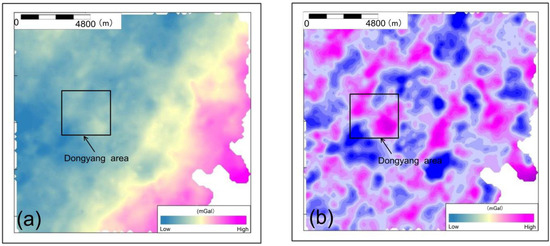
Figure 2.
(a) The Bouguer gravity and (b) the residual gravity anomaly maps of the Dongyang area and its periphery. The black rectangular area denotes the Dongyang area.
From the Bouguer gravity anomaly map and the residual gravity anomaly map (Figure 2), it was discerned that the main body of the Dongyang area is situated in the southwestern inner ring of a giant circular structure. Within this area, two significant residual gravity anomalies are conspicuously distributed. Given the regional geology, it is postulated that these anomalies are correlated with the Xiaoban-Shuangqishan gravity anomaly and the Dongyang-Lingtouping gravity anomaly [32,33].
To investigate the regional deep structures of the Dongyang area and its periphery, this study conducted upward continuations of gravity anomalies to various heights. Subsequently, vertical derivatives of theta maps were calculated to detect the edge [34], enabling multi-scale edge detection. By utilizing boundary information derived from different depths of the geological structure, the distribution of deep-seated fault structures was examined (refer to Figure 3).
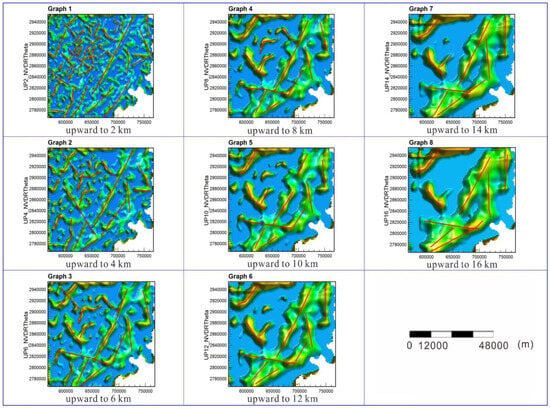
Figure 3.
The multi-scale boundary identification and inference of linear structure from the vertical derivative maps of Theta upward by different heights. The Theta values come from the gravity data, and the red lines represent inferred faults.
3.2. Regional Magnetic Field
In this study, the total magnetic intensity (TMI) after the international geomagnetic reference field (IGRF) was gridded using the Kriging interpolation method with a grid size of 250 m × 100 m. The reduction to the pole (RTP) was transformed using the frequency domain with the inclination and declination of 39.24° and −4.18°, respectively [35,36,37,38,39,40,41,42]. Furthermore, first-order derivatives of the RTP data were enhanced in four horizontal directions (0°, 45°, 90°, 135°), and upward continuation was also carried out [43,44,45].
The magnetic anomaly maps of the Zhongxian region (refer to Figure 4) distinctly revealed the presence of a circular volcanic structure in the central region, along with showcasing the distribution characteristics of regional fault structures. Examination of the horizontal directional derivative maps (see Figure 5) in the region emphasized the distribution patterns of various fault structures in different orientations.
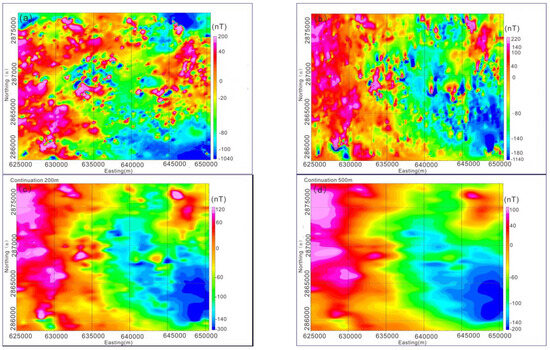
Figure 4.
The magnetic anomaly maps of (a) total magnetic intensity (TMI) after international geomagnetic reference field (IGRF), (b) reduction to the pole (RTP), upward continuation to (c) 200 m and (d) 500 m in the Zhongxian region of the Dongyang area.
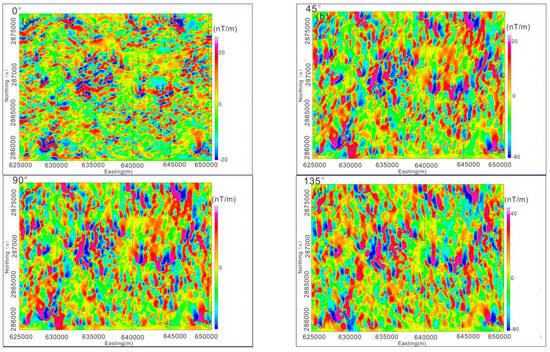
Figure 5.
The horizontal directional derivative maps of (a) 0°, (b) 45°, (c) 90°, and (d) 135°.
Magnetic susceptibility inversion is a data processing technique employed to deduce the physical characteristics and spatial configuration of subsurface materials by analyzing magnetic parameters acquired at the Earth’s surface [46,47]. In this study, a three-dimensional (3D) magnetic susceptibility inversion was executed on magnetic survey data utilizing the MAG3D 4.0 software [48], developed by Columbia University. The inversion was conducted utilizing the original 1:50,000 magnetic RTP data of the volcanic structure in the Zhongxian region without constraint. The software automatically generated a mesh file comprising 84 grids both in the EW (X-axis) and NS (Y-axis) directions, spaced at 100-meter intervals, and 70 vertical grids in the Z direction with increasing spacings in a 50 m × 4 grid, 100 m × 10 grid, 200 m × 15 grid, and 400 m × 5 grid. The model size was 8400 m × 8400 m × 8000 m (X × Y × Z). Default values for the initial and reference models were zero, with a weighting factor of 2 for the depth weighting function.
The magnetic susceptibility inversion model is depicted in Figure 6, while the inversion outcomes are illustrated in Figure 7. The inversion results exhibit a good correlation between the distribution of magnetic bodies (intermediate basic volcanic rocks) linked to the subsurface volcanic structure and the TMI after IGRF (Figure 4a). The presence of magnetic bodies (intermediate basic volcanic rocks) within the underground volcanic structure of the study region suggests a promising potential for deep-seated mineral exploration [49,50].
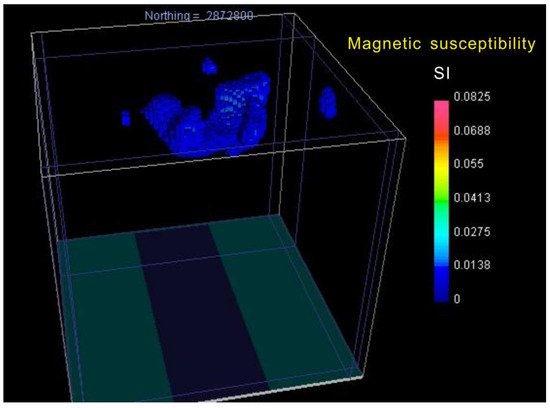
Figure 6.
The 3D magnetic susceptibility inversion model. The magnetic susceptibility of the blue isosurface is 0.01.
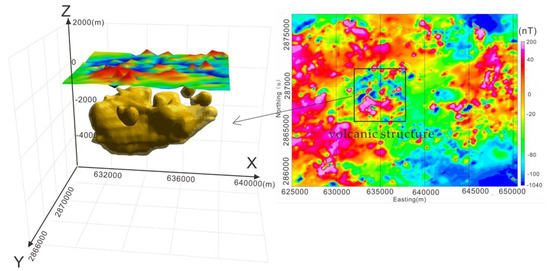
Figure 7.
The magnetic bodies of the volcanic structure in the Zhongxian region by 3D magnetic susceptibility inversion. The right figure is the TMI map after IGRF of the Zhongxian region, and the rectangular area denotes the volcanic structure in the Zhongxian region.
4. Results and Discussion
4.1. Regional Gravity Field Analysis
From the theta vertical derivative maps (Figure 8), it is apparent that the Dongyang area has two sets of NE-trending and NW-trending faults. Furthermore, a radial fault system is discernible in the NE corner of the area. Both the NE-trending and NW-trending faults exhibit distinct features in the theta vertical derivative map, showcasing an upward continuation of 2 km (Figure 8a). As the upward height increases, each of the two NE-trending and two NW-trending faults converges into a single fault in their respective directions. The plane projections of the NW-trending faults shift southwestward, while the NE-trending faults move southeastward, delineating the fault trends. Concurrently, the radial fault system gradually diminishes (Figure 8b), indicating constrained extension space for radial faults, a characteristic trait of volcanic structures. This observation implies the potential presence of a substantial concealed volcanic structure in the Dongyang area.
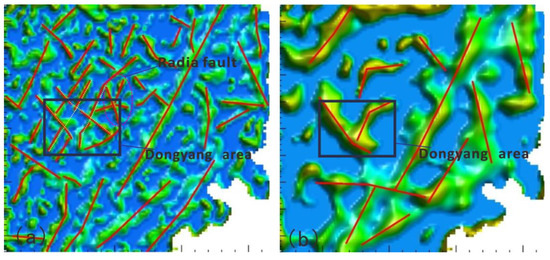
Figure 8.
The inferred structures from the theta vertical derivative maps with upward continuations of (a) 2.0 km and (b) 8.0 km. The red lines represent inferred faults, the black rectangular area denotes the Dongyang area, and the purple dashed lines represent two sets of NE-trending and NW-trending faults.
As the extension height escalates, the linear structures identified by the theta vertical derivative progressively diminish, emphasizing the enhanced representation of deep major fault information and the disappearance of shallow fault details. The multi-scale edge detection of the gravity field effectively unveils the spatial extension characteristics of the primary faults within the Dongyang area and its periphery.
4.2. Regional Magnetic Field Analysis
Based on the TMI after IGRF of the magnetic survey in the Zhongxian region (Figure 4a), the regional magnetic field displays a high degree of complexity, characterized by significant variations in amplitude. Predominantly positive anomalies are observed in the western and northern sectors, while localized positive anomalies are prevalent in the eastern region. A circular pattern of chaotic positive and negative anomalies is discernible in the central area, featuring a distinctive fan-shaped negative anomaly extending from the northeast through the central region to the southeast. Across both positive and negative magnetic field backgrounds, anomalies of varying strength, steepness, and orientations overlap.
The unique characteristics of the regional magnetic field allow for the division of the Zhongxian region into three distinct magnetic zones: Longmen-Donghua-Yangmei (Zone I), Shangzhuang-Huashan-Chunhu-Gaiyang (Zone II), and Jihua-Chiling (Zone III). Zone I is further subdivided into two subzones, as illustrated in Figure 9.
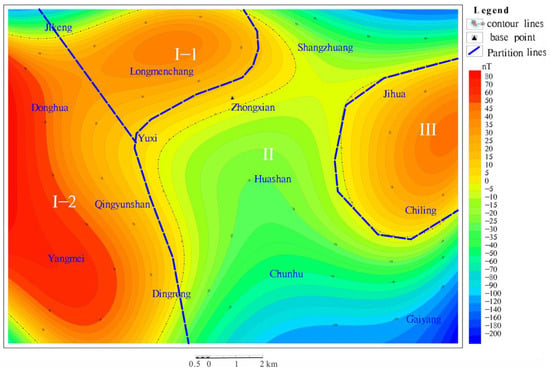
Figure 9.
The magnetic field zoning map of the Zhongxian region. The blue dashed lines represent the magnetic field zones with their number.
- (1)
- Zone I: Longmen-Donghua-Yangmei
Located in the western and northern parts of the Zhongxian region, Longmenchang-Donghua-Yangmei (Zone I) exhibits a large magnetic control area spanning 18 km in length and 12 km in width, with a magnetic anomaly amplitude ranging from −100 to 90 nT. This zone is characterized by the superposition of two positive anomalies and an NW-trending reduced anomaly band. The outer boundaries are delineated by different magnetic zones and gradient bands, with the anomalies being more pronounced on the western side compared to the northern side.
The area is further divided into subzones I-1 and I-2 by a reduced anomaly band running along the Jikeng-Yuxi line. The I-1 subzone, elliptical in shape, trends northeastward, while the I-2 subzone, a strip widening from west to east, trends northwestward with a less distinct northward reduced anomaly band in the middle. The geological background of this magnetic zone is complex, comprising the Late Jurassic Nanyuan Formation and Changlin Formation, Early Jurassic Lishan Formation volcanic rocks, Permian Cuipingshan Formation, Tongziyan Formation, Wenbishan and Qixia Formations, and Nanhua-Qingbaikou Period Mamianshan Group Dalingshan Formation metamorphic rocks, as well as intrusive medium- to fine-grained quartz diorite and quartz monzonite of the Early Caledonian period. Based on geological data, the main uplift in the I-1 subzone is inferred to be associated with Early Caledonian quartz diorite uplift, while the main feature in the I-2 subzone is linked to Early Caledonian quartz monzonite basement. The NW- and NE-trending reduced anomaly bands connecting the outer gradient bands of the magnetic zone are interpreted as representing deeply incised magnetic basement fault structures.
- (2)
- Zone II: Shangzhuang-Huashan-Chunhu-Gaiyang
Situated in the central part of the Zhongxian region, Shangzhuang-Huashan-Chunhu-Gaiyang (Zone II) extends from Shangzhuang in the northeast, through Huashan in the central region, to Gaiyang in the southeast. The magnetic zone forms a “C” shape, spanning 18 km in length and 10 km in width, with a northward and northwestward distribution. The two directions converge near Huashan, with the magnetic field transitioning to a northward extension near Gaiyang. The zone predominantly exhibits negative magnetic characteristics, with a gradual variation in the central area and significant gradient changes on the northern and southern sides. The amplitude varies with higher values in the central region and lower values at both ends, reducing from 0 to −200 nT.
The area primarily exposes the second, third, and fourth sections of the Nanyuan Formation and Changlin Formation, with the western Xixi Formation metamorphic rocks cropping out in the central region. Intrusions of granite porphyry, granodiorite, granite diorite, and quartz diorite are observed in Shangzhuang and Heshun. Based on geological data, the main features of the magnetic zone are interpreted as volcanic rock cover and the non-magnetic or weakly magnetic Changlin Formation. The relatively high anomaly amplitude in the central region is indicative of uplifted acidic-intermediate-neutral rock bodies, while the northward and northwestward magnetic trends are attributed to different fault structures.
- (3)
- Zone III: Jihua-Chiling
Situated in the eastern part of the Zhongxian region, the Jihua-Chiling Zone exhibits a more compact magnetic range, measuring 8.6 km in length and 6.8 km in width. With a semi-elliptical shape, this zone features anomalies trending NE and predominantly displaying positive magnetic characteristics, with amplitudes ranging from 0 to 50 nT. Surface geology in this zone primarily corresponds to the second and third sections of the Nanyuan Formation volcanic rocks, with localized intrusions of late Yanshan granodiorite and exposures of late Jurassic rhyolite. The magnetic field variations are attributed to lithological changes, volcanic rock formation conditions, as well as tectonic and magmatic activities, indicating a prevalence of uplifted granodiorite basement in the magnetic field interpretation.
This detailed zoning and analysis of the magnetic field within the Zhongxian region offer valuable insights into the geological structures and potential mineral resources, significantly enhancing our comprehension and exploration of the region’s subsurface characteristics.
4.3. Interpretation of Fault Structures
The fault structures within the magnetic field exhibit a diverse range of characteristics, manifesting mainly in eight distinct types: boundaries between different magnetic field zones, magnetic anomaly gradient zones, bead-like magnetic anomaly zones, linear anomaly zones, magnetic anomaly abrupt zones, anomalous displacement zones, staggered anomaly zones, and radial groups of anomaly zones. Through an analysis of the magnetic field characteristics of TMI after IGRF, RTP, and upward continuations to 200 m and 500 m in Figure 4, in conjunction with regional gravity field features, a total of 39 fault structures have been inferred within the Zhongxian region. These fault structures predominantly trend in the NE, NNE, NW, and NNW directions, with some also exhibiting near north–south orientations, as shown in Figure 10.
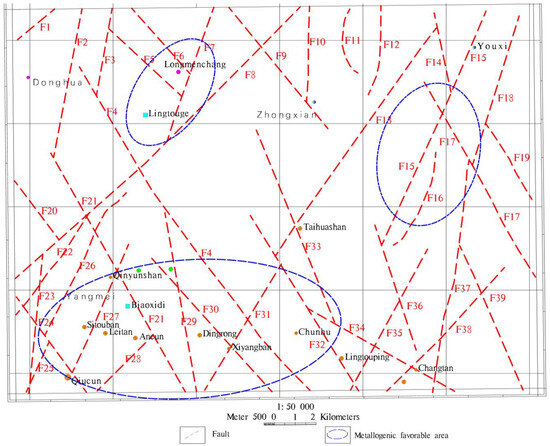
Figure 10.
Fault structure interpretation of the Zhongxian region. The red dashed lines represent inferred fault structures, and the areas enclosed by blue dashed circles denote metallogenically favorable areas.
Within the Zhongxian region, magnetic surveys have identified a total of 19 fault structures trending NE and NNE, including 7 newly recognized faults. NE-trending faults often intersect obliquely with the regional magnetic field, leading to discontinuous magnetic field patterns that frequently manifest as boundaries between different magnetic field zones, linear gradient zones, or bead-like anomalies. Major NE-trending faults such as F8 and F13 exhibit regional characteristics, acting as boundaries within the magnetic field zones. These faults, especially near intersections with NW-trending faults, significantly influence the distribution of gold, lead, zinc, and other polymetallic deposits in the region, with the Qiu Village gold deposit primarily associated with the NNE-trending fault F27.
Similarly, within the Zhongxian region, magnetic surveys have identified 18 fault structures trending NW and NNW, including 8 newly identified faults. NW-trending faults commonly function as boundaries between different magnetic field zones, linear gradient zones, and low-magnetic-value zones, causing discontinuities along the magnetic field. Major NW-trending fault zones, such as F4 and F37, exhibit regional structural significance, with F4 acting as a boundary within the magnetic field zones and F37 closely aligning with geological structures, representing a deeply incised magnetic basement fault structure. These NW-trending fault zones play crucial roles as conduits for the migration of ore-forming elements, influencing the distribution of gold, lead, zinc, and other polymetallic deposits in the region, holding regional ore-controlling importance. Notably, the Xiqian copper–gold deposit and Chunhu gold deposit are believed to be controlled by the NW-trending F29 and F32 fault structures, respectively.
Furthermore, magnetic surveys in the area have identified two nearly NS-trending faults, including one newly recognized fault. NS-trending faults often exhibit characteristics such as bead-like magnetic anomalies and are typically located close to volcanic vents, with F12 forming part of a circular volcanic structure.
4.4. Prospective Mineral Exploration Area
Based on the magnetic and gravity characteristics, in conjunction with the interpreted results and consideration of the known mineral deposits in the Zhongxian region, three promising exploration blocks have been identified with the potential for discovering polymetallic deposits in the region.
- (1)
- Longmenchang Prospective Exploration Area
The Longmenchang area showcases multiple sets of NE- and NW-trending fault structures, including two inferred NE-trending and two NW-trending fault structures. Surface exposures along these structures reveal widespread occurrences of limonite and silicified alteration. At the intersections of these structures, lead–zinc mineralization, limestone, and clay small-scale deposits have been observed. The favorable exploration conditions in this area suggest significant potential for mineralization. Exploration efforts should prioritize investigating relevant mineral deposits near fault and lithological contact zones.
- (2)
- Qingyunshan-Qiucun-Chunhu Prospective Area
Within this area, 14 faults have been identified, consisting of seven NE-trending and seven NW-trending structures. Surface occurrences of silicification, pyritization, and limonitization alterations are prevalent. At the intersections of these structures, four gold mineralization points, six small-scale gold deposits, and one medium-sized gold deposit have been discovered. Given these findings, the exploration conditions in this area are considered favorable. Exploration activities should emphasize the exploration of concealed gold deposits by integrating alteration zone factors at fault contact zones and rock boundaries.
- (3)
- Youxijihua-Yongtai Zhufeng Prospective Area
In this region, fault structures predominantly trend in the NE and ENE directions. One NE-trending and one NW-trending structure have been inferred, with the NE-trending structure identified as a significant ore-controlling structure. Intensive surface alteration is evident, characterized by silicification, pyritization, and limonitization alterations. The overall assessment indicates favorable exploration conditions in this area. Prospecting endeavors should focus on exploring concealed gold mineralization near lithological contact zones and structural belts.
5. Conclusions
The Dongyang area is strategically located within the “Golden Triangle” gold deposit area of Fujian Province, China, characterized by exceptional metallogenic geological settings and promising mineralization potential. This study meticulously gathered and processed gravity data from the Dongyang area and its periphery. Additionally, a precise 1:50,000 magnetic survey was carried out in the Zhongxian region of the Dongyang area. The research involved comprehensive data processing and information extraction from the gravity and magnetic datasets, facilitating a thorough examination of the deep-seated geological structures in the Zhongxian region.
The findings reveal a well-developed network of deep-seated fault structures in the Zhongxian region, predominantly oriented in the northeast and northwest directions. A total of 39 inferred faults were delineated, encompassing 19 NE- and NNE-trending faults, 18 NW- and NNW-trending faults, and 2 nearly NS-trending faults. Through the integration of regional geological data, three prospective mineral exploration zones were identified.
This study offers initial insights into the deep-seated geological structural characteristics of the region, providing valuable geophysical data and a foundation for extensive mineral exploration endeavors in the Dongyang area. Furthermore, it holds significant implications for advancing the understanding of metallogenic theories and mineralization patterns within the “Golden Triangle” gold deposit region of Fujian, China.
This study only focuses on gravity and magnetic exploration, inferring the deep-seated fault structures in the Zhongxian region based on gravity and magnetic features. It provided a preliminary understanding of the deep-seated geological structures in the Zhongxian region. To obtain better understanding of the regional deep-seated geological structures, further integrated geophysical exploration methods such as magnetotelluric sounding and seismic surveys need to be conducted.
Author Contributions
Conceptualization, Z.Z. and Y.L.; methodology, Z.Z. and L.C.; software, Z.Z. and L.C.; investigation and validation, Z.Z., Y.L. and L.C.; writing—original draft preparation, Z.Z. and Y.L.; writing—review and editing, all participants; supervision, Y.L., Y.S. and Q.Z. All authors have read and agreed to the published version of the manuscript.
Funding
This research was funded by the National Key Research and Development Program (grant number 2016YFC0600210) and the China Geological Survey Project (grant number DD20230310).
Data Availability Statement
Data are available on request from the authors. The data are not publicly available due to confidentiality.
Acknowledgments
The authors would like to thank the anonymous reviewers and editors for their valuable suggestions.
Conflicts of Interest
The authors declare no conflicts of interest.
References
- Zhdanov, M.S.; Wan, L.; Jorgensen, M. Joint Three-Dimensional Inversion of Gravity and Magnetic Data Collected in the Area of Victoria Mine, Nevada, Using the Gramian Constraints. Minerals 2024, 14, 292. [Google Scholar] [CrossRef]
- Meng, Q.F.; Ma, G.Q.; Li, L.L.; Wang, T.T.; Li, Z.R.; Wang, N.; Li, J.G. Joint Inversion of Gravity and Magnetic Data with Tetrahedral Unstructured Grid and its Application to Mineral Exploration. IEEE Trans. Geosci. Remote Sens. 2023, 61, 5915514. [Google Scholar] [CrossRef]
- Essa, K.S.; Abo-Ezz, E.R.; Anderson, N.L.; Gomma, O.A.; Elhussein, M. Magnetic inversion approach for modeling data acquired across faults: Various environmental cases studies. Acta Geophys. 2024, 72, 1819–1845. [Google Scholar] [CrossRef]
- Essa, K.S.; Mehanee, S.A.; Elhussein, M. Gravity data interpretation by a two-sided fault-like geologic structure using the global particle swarm technique. Phys. Earth Planet. Inter. 2021, 311, 106631. [Google Scholar] [CrossRef]
- Mehanee, S.; Essa, K.S.; Diab, Z.E. Magnetic data interpretation using a new R-parameter imaging method with application to mineral exploration. Nat. Resour. Res. 2021, 30, 77–95. [Google Scholar] [CrossRef]
- Essa, K.S.; Mehanee, S.; Elhussein, M. Magnetic Data Profiles Interpretation for Mineralized Buried Structures Identification Applying the Variance Analysis Method. Pure Appl. Geophys. 2021, 178, 973–993. [Google Scholar] [CrossRef]
- Prutkin, I.; Vajda, P.; Jahr, T.; Bleibinhaus, F.; Novák, P.; Tenzer, R. Interpretation of gravity and magnetic data with geological constraints for 3D structure of the Thuringian Basin, Germany. J. Appl. Geophys. 2017, 136, 35–41. [Google Scholar] [CrossRef]
- Wei, D.G.; Jie, Y.J. Characteristics of Regional Geological Structures in Fujian Province. Reg. Geol. China 1997, 16, 162–171. [Google Scholar]
- Yuan, H.X.; Chen, H.H. Progress in mineral exploration and characteristics of gold mineralization in Dehua area, Fujian. J. Mineral. 2015, 35, 1055. [Google Scholar]
- Li, G.K. The relationship between the basic framework of Fujian’s tectonic structure and the distribution of metallic minerals. Reg. Geol. China 1982, 1, 55–65. [Google Scholar]
- Xiang, H.L. The controlling factors and genesis of the Qiuchun gold deposit in Fujian. Gold Geol. 2002, 1, 40–43. [Google Scholar]
- Zhou, W.Y. Geological characteristics, ore-forming conditions, and ore-forming laws of gold deposits in the Youxi Dehua Yongtai area of central Fujian. Geol. Fujian 1996, 15, 199–208. [Google Scholar]
- Bao, S.Z. Discussion on the ore control conditions and prospecting direction of Fujian Yan Gold Mine. Fujian Geol. 2015, 34, 289–297. [Google Scholar]
- Mao, J.W.; Xie, G.Q.; Li, X.F.; Zhang, C.Q.; Mei, Y.W. Mesozoic large scale mineralization and multiple lithospheric extension in south China. Earth Sci. Front. 2004, 11, 46–56. [Google Scholar]
- Hua, R.M.; Chen, P.R.; Zhang, W.L.; Lu, J.J. Three major metallogenic events in Mesozoic in South China. Miner. Depos. 2005, 24, 99–107. [Google Scholar]
- Yue, L.Q.; Huang, C.P.; Zhang, K.Y. Discussion on the metallogenic epoch of gold deposits in Fujian province, southeast China. Geol. Prospect. 2002, 38, 17–21. [Google Scholar]
- Xu, N. A Study on the Metallogenic System and Genesis of Dongyang Gold Mine in Fujian Province. Ph.D. Thesis, China University of Geosciences, Beijing, China, 2017. [Google Scholar]
- Xu, Q.H.; Xie, W.Q.; Chen, Y.R. A Comprehensive Geochemical Anomaly Zoning Model and Exploration Prediction Indicators for Qiuchun Gold Mine in Fujian Province. Geol. Explor. 2005, 1, 56–61. [Google Scholar]
- Lei, F.Z. A Study on the Genesis of Shallow Hydrothermal Gold Deposits in Dongyang, Fujian Province. Ph.D. Thesis, Jilin University, Changchun, China, 2019. [Google Scholar]
- Huang, C.P. Research on the Metallogenic Characteristics and Prediction of Gold Deposits in Fujian Province. Ph.D. Thesis, China University of Geosciences, Beijing, China, 2017. [Google Scholar]
- Zhang, Z.; Hu, X.; Fang, H.; Wang, D. Study on Deep Geological Structure in Dongyang Area of Fujian Province, and Provide Theoretical Basis for Deep Prospecting Breakthrough. In AGU Fall Meeting; The SAO Astrophysics Data System: San Francisco, CA, USA, 2019. [Google Scholar]
- Li, G.K.; Liang, S.J. Regional geological characteristics of Fujian province. Geol. Bull. China 1987, 3, 201–210. [Google Scholar]
- Wang, J.F. Preliminary opinions on the geological structural characteristics of Fujian and the ore-forming relationship of magmatic activity. Jiangxi Build. Mater. 2016, 12, 236. [Google Scholar]
- Zhang, X.X. A Study on the Formation and Structural Deformation Evolution of the Neoproterozoic Mamianshan Group in the Central Fujian Region. Ph.D. Thesis, China University of Geosciences, Beijing, China, 2017. [Google Scholar]
- Chen, D.W. Geological characteristics of the Shuangqishan gold deposit in Fujian and analysis of its potential for prospecting in the surrounding areas of the mining area. Geol. Fujian 2012, 31, 1–11. [Google Scholar]
- Zhu, Y.L.; Liu, Y.F.; Zhang, J.T. Geological characteristics and genesis of Xiaban porphyry gold deposit in Dehua, Fujian. Geol. Fujian 2009, 28, 21–35. [Google Scholar]
- Lei, F.Z.; Sun, J.G.; Xu, Z.T.; Han, J.L.; Liu, Y. A Study on the Metallogenic Process and Genesis of the Dongyang Shallow Hydrothermal Gold Deposit in Dehua, Fujian Province. World Geol. 2019, 38, 339–353. [Google Scholar]
- Lin, Z.L. Geological characteristics and genesis of gold deposits in the Fufenglin mining area of Dehua, Fujian. Geol. Fujian 2019, 38, 208–215. [Google Scholar]
- Duan, G.; Chen, H.; Xu, C.; Qi, J. Metallogenic Model of Porphyry Shallow Temperature Superimposition in the Shandong South Oreblock of Zijin, Fujian Province. J. Mineral. 2015, 35, 12. [Google Scholar]
- Mao, G.W.; Tan, Y.S.; He, D.H.; Nie, D.P.; Liu, X.D. Exploration of mineralization types and prospecting directions in the Jinban ore section of the Taihua Mountain gold deposit in central Fujian. Depos. Geol. 2017, 36, 736–748. [Google Scholar]
- Wang, X.Z. Geological characteristics and ore-forming prediction of the Xiaoban East Belt gold deposit in Youxi, Fujian. Energy Environ. 2016, 2, 112–113. [Google Scholar]
- Ren, Z.Y.; Liu, J.X.; Yue, G.X.; Zhang, Y.L. Research progress of gravity and magnetic methods in the exploration of non-ferrous metal minerals. Chin. J. Nonferrous Met. 2023, 33, 240–260. [Google Scholar]
- Liu, H.L.; Chen, C.D.; Fan, J.J.; Zhang, X.; Peng, W.X.; Zhang, W. Fault structure identification based on gravity data and its application in the Wuwei area. World Geol. 2023, 42, 334–342. [Google Scholar]
- Wijns, C.; Perez, C.; Kowalczyk, P. Theta map: Edge detection in magnetic data. Geophysics 2005, 70, L39–L43. [Google Scholar] [CrossRef]
- Shen, H.Y. Research on Computer Automatic Identification and Zoning Technology for Regional Magnetic Anomaly. Master’s Thesis, China University of Geosciences, Beijing, China, 2019. [Google Scholar]
- Yang, J.; Wang, Q.; Guo, J.; Zeng, Q.Q. Wavelet modulus maximum decomposition of gravity and magnetic anomalies and its application in Beiya mining area. Geophys. Geochem. Explor. Calc. Technol. 2019, 41, 485–494. [Google Scholar]
- Wei, M.J. Determination of Normal Field Values in Magnetic Exploration. China Sci. Technol. Inf. 2012, 23, 35–40. [Google Scholar]
- Guo, L.H.; Meng, X.H.; Shi, L.; Chen, Z.X. Optimized Filtering Method and Its Application to Bouguer Gravity Anomaly Data Processing in Chinese Mainland. J. Geophys. 2012, 55, 4078–4088. [Google Scholar]
- Yao, C.L.; Li, H.W.; Zheng, Y.M.; Meng, X.H.; Zhang, Y.W. Comprehensive Analysis and Research on Iterative Method in Calculation of Gravity and Magnetic Potential Field Conversion. J. Geophys. 2012, 55, 2062–2078. [Google Scholar]
- Zhang, F.X. Research on High-Precision Gravity Anomaly Data Processing Methods and Technologies. Ph.D. Thesis, Jilin University, Changchun, China, 2006. [Google Scholar]
- Li, L.; Wu, Y.G.; Yang, C.B.; Huan, H.F.; Guo, C.C. Several boundary identification methods of gravity data and application in Vientiane of Laos area. Glob. Geol. 2014, 17, 55–61. [Google Scholar]
- Gordon, G.R.J.; Duncan, D.R. Edge enhancement of potential-field data using normalized statistics. Geophysics 2008, 71, H1–H4. [Google Scholar]
- Xu, S.Z. Integral Iterative Method for Potential Field Extension. J. Geophys. 2006, 4, 1176–1182. [Google Scholar]
- Zhang, Z.H.; Wu, L.Y. The correlation coefficient method for downward extension of potential field. J. Jilin Univ. (Earth Sci. Ed.) 2012, 42, 1912–1919. [Google Scholar]
- Gao, Y.W.; Luo, Y.; Wen, W. Research and application of compensation downward extension method. J. Geophys. 2012, 55, 2747–2756. [Google Scholar]
- Jia, Z.; Li, Y.S.; Wang, Y.H.; Li, Y.; Jin, S.B.; Li, Y.X.; Lu, W.K. Deep Learning for 3-D Magnetic Inversion. IEEE Trans. Geosci. Remote Sens. 2023, 61, 5905410. [Google Scholar] [CrossRef]
- Utsugi, M. 3-D inversion of magnetic data based on the L1–L2 norm regularization. Earth Planets Space 2019, 71, 73. [Google Scholar] [CrossRef]
- Li, Y.; Oldenburg, D.W. 3-D inversion of magnetic data. Geophysics 1996, 61, 394–408. [Google Scholar] [CrossRef]
- Wang, W.Y.; Qiu, Z.Y.; Yang, Y.; Shi, W.J. Research progress in edge recognition methods for potential fields. Prog. Geophys. 2010, 25, 196–210. [Google Scholar]
- Ma, L.; Meng, J.H.; Shan, Z.X.; Li, X.L.; Li, F.Y.; Jin, Y.M.; Wang, J.H.; Li, B.L. Comparison and application research on new methods for identifying the boundaries of gravity and magnetic anomaly sources. Prog. Geophys. 2017, 32, 2514–2519. [Google Scholar]
Disclaimer/Publisher’s Note: The statements, opinions and data contained in all publications are solely those of the individual author(s) and contributor(s) and not of MDPI and/or the editor(s). MDPI and/or the editor(s) disclaim responsibility for any injury to people or property resulting from any ideas, methods, instructions or products referred to in the content. |
© 2024 by the authors. Licensee MDPI, Basel, Switzerland. This article is an open access article distributed under the terms and conditions of the Creative Commons Attribution (CC BY) license (https://creativecommons.org/licenses/by/4.0/).